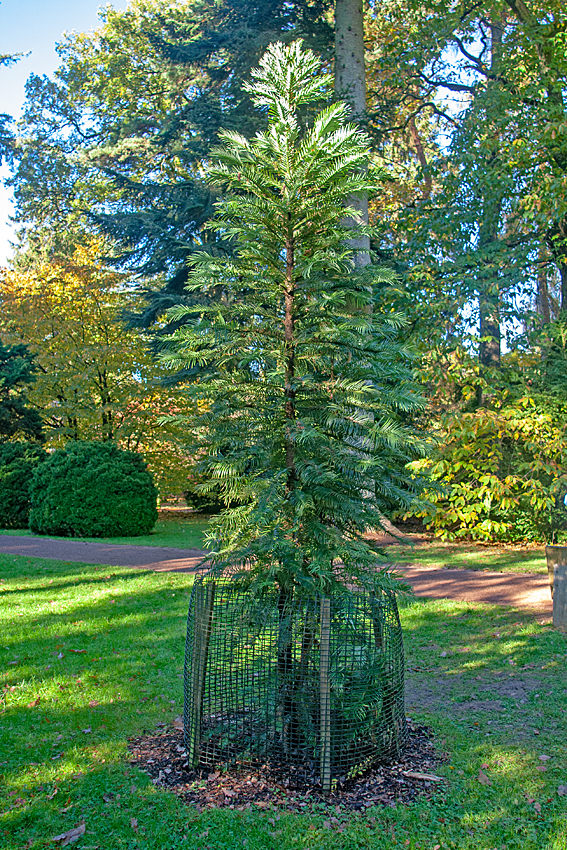|
Trident Maple
''Acer buergerianum'' (trident maple; ) is a species of maple native to eastern China (from Shandong west to southeastern Gansu, south to Guangdong, and southwest to Sichuan), Taiwan and Japan. The specific epithet is a patronym honoring Dutch plant hunter J. Buerger (1804-1858). Description It is a small to medium-sized deciduous tree reaching a height of 5–20 m with a trunk up to 50 cm diameter. The leaves are in opposite pairs, 2.5–8 cm long (excluding the 2–5 cm petiole) and 3.5–6.5 cm broad, hard, glossy dark green above, paler below, usually with three lobes; on mature trees the lobes forward-pointing and with smooth margins, on young trees with more spreading lobes and serrated margins. The flowers are produced in spring, yellow-green, in pendulous corymbs; they are small, with five greenish sepals and five yellow-white petals about 2 mm long, and eight stamens. The fruit is a samara with two winged seeds, each seed 4–7 mm diameter, w ... [...More Info...] [...Related Items...] OR: [Wikipedia] [Google] [Baidu] |
Friedrich Anton Wilhelm Miquel
Friedrich Anton Wilhelm Miquel (24 October 1811 – 23 January 1871) was a Dutch botanist, whose main focus of study was on the flora of the Dutch East Indies. Early life Miquel was born in Neuenhaus and studied medicine at the University of Groningen, where, in 1833, he received his doctorate. After starting work as a doctor at the Buitengasthuis Hospital in Amsterdam, in 1835, he taught medicine at the clinical school in Rotterdam. In 1838 he became correspondent of the Royal Institute, which later became the Royal Netherlands Academy of Arts and Sciences, and in 1846 he became member. He was professor of botany at the University of Amsterdam (1846–1859) and Utrecht University (1859–1871). He directed the Rijksherbarium (National Herbarium) at Leiden from 1862. In 1866, he was elected a foreign member of the Royal Swedish Academy of Sciences. Research Miquel did research on the Taxonomy (biology), taxonomy of plants. He was interested in the flora of the Dutch Empire, speci ... [...More Info...] [...Related Items...] OR: [Wikipedia] [Google] [Baidu] |
Seed
A seed is an embryonic plant enclosed in a protective outer covering, along with a food reserve. The formation of the seed is a part of the process of reproduction in seed plants, the spermatophytes, including the gymnosperm and angiosperm plants. Seeds are the product of the ripened ovule, after the embryo sac is fertilized by sperm from pollen, forming a zygote. The embryo within a seed develops from the zygote, and grows within the mother plant to a certain size before growth is halted. The seed coat arises from the integuments of the ovule. Seeds have been an important development in the reproduction and success of vegetable gymnosperm and angiosperm plants, relative to more primitive plants such as ferns, mosses and liverworts, which do not have seeds and use water-dependent means to propagate themselves. Seed plants now dominate biological niches on land, from forests to grasslands both in hot and cold climates. The term "seed" also has a general me ... [...More Info...] [...Related Items...] OR: [Wikipedia] [Google] [Baidu] |
Ramification (botany)
In botany, ramification is the divergence of the stem and limbs of a plant into smaller ones, i.e., trunk into branches, branches into increasingly smaller branches, and so on. Gardeners stimulate the process of ramification through pruning, thereby making trees, shrubs, and other plants bushier and denser. Short internodes (the section of stem between nodes, i.e., areas where leaves are produced) help increase ramification in those plants that form branches at these nodes. Long internodes (which may be the result of over-watering, the over-use of fertilizer, or a seasonal "growth spurt") decrease a gardener's ability to induce ramification in a plant. A high degree of ramification is essential for the creation of topiary as it enables the topiary artist to carve a bush or hedge into a shape with an even surface. Ramification is also essential to practitioners of the art of bonsai as it helps re-create the form and habit of a full-size tree in a small tree grown in a contai ... [...More Info...] [...Related Items...] OR: [Wikipedia] [Google] [Baidu] |
Bonsai
Bonsai ( ja, 盆栽, , tray planting, ) is the Japanese art of growing and training miniature trees in pots, developed from the traditional Chinese art form of ''penjing''. Unlike ''penjing'', which utilizes traditional techniques to produce entirely natural scenery in small pots that mimic the grandiose shapes of real life scenery, the Japanese "bonsai" only attempts to produce small trees that mimic the shape of real life trees. Similar versions of the art exist in other cultures, including the miniature living landscapes of Vietnamese . It was during the Tang dynasty, when ''penjing'' was at its height, that the art was first introduced in Japan. The loanword "bonsai" (a Japanese pronunciation of the Chinese term ''penzai'') has become an Hyponymy and hypernymy, umbrella term in English, attached to many forms of diminutive potted plants, and also on occasion to other living and non-living things. According to Stephen Orr in ''The New York Times'', "the term should be rese ... [...More Info...] [...Related Items...] OR: [Wikipedia] [Google] [Baidu] |
Arnold Arboretum
The Arnold Arboretum of Harvard University is a botanical research institution and free public park, located in the Jamaica Plain and Roslindale neighborhoods of Boston, Massachusetts. Established in 1872, it is the oldest public arboretum in North America. The landscape was designed by Charles Sprague Sargent and Frederick Law Olmsted and is the second largest "link" in the Emerald Necklace. The Arnold Arboretum's collection of temperate trees, shrubs, and vines has a particular emphasis on the plants of the eastern United States and eastern Asia, where arboretum staff and colleagues are actively sourcing new material on plant collecting expeditions. The arboretum supports research in its landscape and in its Weld Hill Research Building. History The Arboretum was founded in 1872 when the President and Fellows of Harvard College became trustees of a portion of the estate of James Arnold (1781–1868), a whaling merchant from New Bedford, Massachusetts. Arnold specified that ... [...More Info...] [...Related Items...] OR: [Wikipedia] [Google] [Baidu] |
Boskoop
Boskoop () is a town in the province of South Holland. It was a separate municipality until it merged into Alphen aan den Rijn in 2014. The town had a population of 15,050 in 2012 and covers an area of of which is water. It's the world's biggest joined floriculture area. Boskoop is famous for its nurseries, particularly woody plant and perennial nurseries, of which some 774 are situated on long stretches of land, divided by narrow canals. Before World War II almost all transport was conducted using narrow boats. A few exceptionally high footbridges crossing some of the broader (main) canals remain from these days. Between the World Wars the transition was made from fruit culture to decorative garden plants and trees. As a source of technical knowledge about the art of growing decorative plants, Boskoop remains world-renowned and unique. The name "Boskoop" has been given to an apple cultivar (Belle de Boskoop) which is widely distributed in the Low Countries, to a grape variety ... [...More Info...] [...Related Items...] OR: [Wikipedia] [Google] [Baidu] |
Esveld Aceretum
Esveld Aceretum is (in the number of species and cultivars under cultivation at the site) the largest collection of maples in the world.''Maples for Gardens: A Color Encyclopedia'' by C.J. van Gelderen & D.M. van Gelderen, 1999 The aceretum is part of PlantenTuin Esveld, a family-owned commercial nursery in Boskoop, Netherlands, that was founded in 1865. The term "aceretum" describes an arboretum devoted to maple trees and shrubs, i.e. plants belonging to the genus ''Acer''. The aceretum was founded in the early 1970s, anchored by a giant specimen of '' Acer shirasawanum'' that was already about one century old. The aceretum now holds over 600 varieties of maples and is the holder of the Dutch Plant Collections of ''Acer.'' PlantenTuin Esveld is the holder of the national collections of several other Genus of plants as well. References External links Official website Netherlands ) , anthem = ( en, "William of Nassau") , image_map = , map_caption = , subd ... [...More Info...] [...Related Items...] OR: [Wikipedia] [Google] [Baidu] |
England
England is a country that is part of the United Kingdom. It shares land borders with Wales to its west and Scotland to its north. The Irish Sea lies northwest and the Celtic Sea to the southwest. It is separated from continental Europe by the North Sea to the east and the English Channel to the south. The country covers five-eighths of the island of Great Britain, which lies in the North Atlantic, and includes over 100 smaller islands, such as the Isles of Scilly and the Isle of Wight. The area now called England was first inhabited by modern humans during the Upper Paleolithic period, but takes its name from the Angles, a Germanic tribe deriving its name from the Anglia peninsula, who settled during the 5th and 6th centuries. England became a unified state in the 10th century and has had a significant cultural and legal impact on the wider world since the Age of Discovery, which began during the 15th century. The English language, the Anglican Church, and Engli ... [...More Info...] [...Related Items...] OR: [Wikipedia] [Google] [Baidu] |
Westonbirt Arboretum
Westonbirt, The National Arboretum is an arboretum in Gloucestershire, England, about southwest of the town of Tetbury. Managed by Forestry England, it is perhaps the most important and widely known arboretum in the United Kingdom. Planted in the heyday of Victorian plant hunting in the mid-19th century as part of the Westonbirt House estate, the arboretum forms part of a site which is listed Grade I on the Register of Historic Parks and Gardens of special historic interest. History There is evidence of coppicing at the site from 1292. First use of the name "" was in 1309. This was taken from Weston, a settlement to the west of Bowldown Road, and Birt from then lords of the manor, the Bret family. The arboretum was established in 1829 by Robert Stayner Holford and was later extended by his son George Lindsay Holford. After the death of George in 1926, ownership of the arboretum passed to his nephew, the fourth Earl of Morley, and eventually to the Forestry Commission in 1 ... [...More Info...] [...Related Items...] OR: [Wikipedia] [Google] [Baidu] |




